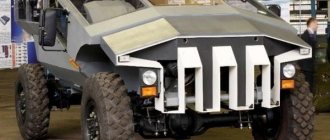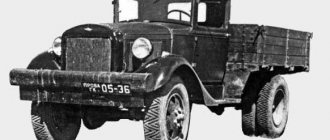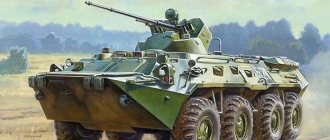The Kama Automobile Plant mass-produced the KamAZ-55111 dump truck from 1987 to 2012. Therefore, this truck can safely be called one of the most popular vehicles of the famous domestic brand.
This model is a 3-axle 6x4 vehicle equipped with a standard metal dump body, which provides rear unloading and has a volume of 6.6 m3.
The technical characteristics made the KamAZ 55111 dump truck a universal machine, which was used in almost all areas of industry and the country's economy.
About the history of the model and its place in the KamAZ production program
KamAZ-55111 dates back to the mid-70s of the twentieth century. The rapid economic growth and construction boom that unfolded this decade has created an increased demand for trucks of this class. But the USSR auto industry did not yet have a sufficient number of models of such dump trucks. In 1977, serial production of the KamAZ-5511 dump truck with an all-metal welded body began.
This truck had a carrying capacity of 10 tons and was perfectly suited for transporting any cargo, primarily bulk construction materials. It was equipped with a hydraulic body lifting mechanism, with electro-pneumatic remote control from the driver’s cab.
KamAZ-5511 was used literally everywhere: on construction sites and in various industries; in the construction of roads and bridges; in agriculture, etc. More precisely, it is still in use: this model remained on the KamAZ assembly line until 1990, and some of these trucks are still “in good health” and continue to work.
KamAZ-55111 became a modernized version of the 10-ton KamAZ-5511. It differed from its predecessor in having a shorter body than the 5511, and, accordingly, better maneuverability. The vehicle's carrying capacity increased to 13 tons. The machine is designed to operate on roads designed for vehicles with an axle load of 100 kN (10 tf).
Otherwise, it was the same 6x4 three-axle dump truck as before. In the first years, KamAZ-55111 had the same cab as the original model 5511 - with round, high-mounted headlights. Subsequently, the KamAZ-55111 cab was restyled, like the cabs of other Kama truck models.
Visually: KamAZ-55111 with an old and a newer cabin. The body has also changed, noticeably increasing in volume.
In 1998, the Kama Automobile Plant began producing a more modern model of a three-axle dump truck, which received the industry index KamAZ-65115. The carrying capacity of this truck was increased to 15 tons. The modernized KamAZ-65115 finally replaced KamAZ-55111 in the plant’s production program. This happened in 2012.
Another related model is the KamAZ-65111 three-axle dump truck with a lifting capacity of 14 tons. This is an all-wheel drive truck with a 6x6 wheel arrangement, designed for use in difficult road conditions and off-road conditions. It continues to be produced to this day.
General information
The USSR auto industry did not have a large number of models belonging to the group of dump trucks. At the same time, the construction boom and significant economic growth that began in 1970 revealed a high demand for cars of this class. The first vehicle of the group was the KamAZ 5511, introduced in 1977. The concept of the basic modification turned out to be very successful, which was confirmed by the huge demand for it. The car existed almost unchanged until 1990. By that time, the dump truck was seriously outdated, and the company started thinking about creating a new model. As a result, in 1988, KamAZ 55111 was presented, which was based on the KamAZ 5511 base.
Specialists from the Kama Automobile Plant and a machine-building enterprise located in Mytishchi participated in the creation of the car. The design of the equipment consisted of 3 axes, and most of the parts were standard, which made repairs easier. At the same time, many new solutions have appeared in the design of KamAZ 55111. Thus, the car received headlights with an asymmetrical beam, reducing the likelihood of dazzling drivers of oncoming cars. Another innovation was the alarm system, made in the form of flashing turn signals.
The new product of the Kama Automobile Plant was noticeably different from the previous equipment produced by Soviet enterprises. Yellow dump trucks have become the trademark of the brand and are firmly established as leaders in their class. The chassis for the KamAZ 55111 model was produced in Naberezhnye Chelny, and the body and tipping system in Neftekamsk.
The main difference between the car and its predecessor was the shortened body, which made it more maneuverable and compact. Initially, KamAZ 55111 was equipped with a cab for operators of the original model. Only a few years after its appearance, it was equipped with a modernized operator’s cabin with a significant roof. The model was repeatedly modified, increasing power, performance and load capacity, improving individual elements and creating new modifications. All this ensured the car a long “life”.
KamAZ 55111 was produced in the following main modifications:
- KamAZ 55111-18 is the basic version with a load capacity of 13 tons. It was available in 2 versions: for northern regions with temperatures up to -50 degrees and for hot conditions;
- KamAZ 55111-16 is a model for use with dump trailers. Equipped with a towing device and electric and hydraulic pneumatic outlets;
- KamAZ 55102 is a dump truck designed for agriculture. It had a platform with folding sides and unloading from the side.
KamAZ 55111 was considered one of the most successful models of the Kama Automobile Plant and had a wide range of applications. Thanks to its welded all-metal platform, it was ideal for transporting a variety of cargo types, including bulk cargo. The presence of a heating system made it possible to unload during cold periods of the year, preventing cargo from freezing to the platform. KamAZ 55111 is a road dump truck designed for use on public roads. It is used on construction sites, in industry, when laying roads, agriculture and other industries.
Modifications of the KamAZ-55111 dump truck
Over the years of production, in addition to the basic model of the dump truck, the production of several specialized modifications of the KamAZ-55111 was launched, namely:
- KamAZ-55111-016-02 is a dump truck designed to work with a trailer as part of a road train. Equipped with a towing device and hydraulic outlets that ensure lifting of the trailer’s cargo platform;
- KamAZ-55111-018-02 - a truck with a reinforced gearbox, a 240-horsepower diesel engine, an increased fuel tank of 350 liters and heating of the dump platform with exhaust gases;
- KamAZ-55111-018-13 - a dump truck with an engine boosted to 260 horsepower, a cross-axle differential locking system and a reinforced clutch system;
- KamAZ-55111-040-02 - a truck with an all-metal dump platform increased to 8 cubic meters
KamAZ-5511 photo. Car history
| KAMAZ: fuel consumption In addition, the vehicle has a brake release system for compressing the springs of energy accumulators, which are activated when the auxiliary or parking brake is applied. More details about the KamAZ 55111 engine and its components can be found in the repair and maintenance manual for KamAZ vehicles, starting from page 14. |
- KamAZ-6520-006,
- KamAZ-6520-60006,
- KamAZ-6520-001,
- KamAZ-6520-026-06,
- KamAZ-6520-032,
- KamAZ-6520-007,
- KamAZ-6520-036,
- KamAZ-6520-037,
- KamAZ-6520-120.
What affects fuel consumption
Without exaggeration, KamAZ family vehicles can be called real workers of the national economy. They are reliable, have good cross-country ability, and when traveling on Russian roads this is of great importance. But there is also one significant drawback in the form of fuel consumption.
Fuel consumption differs in urban areas and on the highway
Most heavyweights spend from 30 to 40 liters of fuel for every hundred kilometers. At the same time, the consumption of KamAZ depends not only on the modification of the vehicle and the purpose of use. There are many other factors to consider:
- Quality of the road surface. You have to drive on a bad road in a low gear.
- Features of the winter period. In low temperature conditions, the engine warms up to operating temperature much more slowly, which results in increased fuel consumption.
- Condition of the brake system. Lack of air in the system leads to increased load on the power unit.
- Engine serviceability. Due to wear of the piston group, compression, which is necessary for normal engine performance, decreases.
- Air filter clogged. The difficulty of air flow in the intake manifold also results in increased fuel consumption.
- Exceeding permissible weight limits. Excessively heavy loads cause a lot of trouble for the engine, as it puts a lot of stress on it.
- Transmission oil quality. Transmission components deprived of lubrication will also place additional stress on the vehicle’s power plant, which will result in increased friction.
The technical characteristics of the engine and transmission, although they influence the car’s fuel consumption, its quality also plays an important role! Manufacturers usually indicate fuel consumption when the vehicle is fully loaded (within normal limits).
KamAZ-55111 dump truck engine
The engine of this model is classic KamAZ - model KamAZ-740. Over the years of production, various modifications of this diesel engine were installed on the car - both naturally aspirated and with a turbocharging system. The most widely used version of the KamAZ-55111 was the KamAZ-740.51-240, with a turbocharging system and intercooling of the charge air.
Like other modifications, it is an eight-cylinder diesel engine with a V-shaped cylinder arrangement. Its working volume is 10.85 liters, and its rated power is 176 kW, or 240 horsepower (at a crankshaft speed of 2200 rpm). The power unit meets the requirements of the Euro-2 environmental standard. The compression ratio of this engine is 16.5.
To guarantee reliable starting in frosty weather, the engines of KamAZ-55111 dump trucks were supplemented with pre-start heaters of the PZD 15.8106-01 model. This engine provides diesel fuel consumption of around 30 liters per 100 kilometers.
Description of the cabin interior
The KamAZ 55111 cabin was manufactured from solid metal. Two people can easily fit inside – a driver and a passenger. The cabin itself is located above the power unit and is equipped with a high roof. The developers managed to qualitatively protect it from the penetration of cold air and guarantee an acceptable level of sound insulation.
Please note that there is no place for rest and sleep in the cabin.
To decorate the interior of KamAZ 55 111, simple but strong materials were used. The seats are quite comfortable and high.
Transmission
The following mechanical gearboxes were used in the transmission of KamAZ-55111 vehicles: 5-speed 14th modification - without a divider, with a final drive ratio of 7.22, and 5-speed 15th modification with a divider and a final drive ratio of 6 ,53. The gearbox drive is mechanical, remote, with a floor lever. With a divider, the number of gears is 10. To transmit torque from the engine to the transmission elements, a diaphragm or friction dry double-disc clutch was used. Clutch control is hydraulic, with pneumatic booster.
Vehicle power system
KamAZ-5511 vehicles use a single-wire power supply system with a voltage of 24 Volts. Two 6-ST-190 starter batteries are installed in a special compartment on the right side of the frame. The "minus" of the on-board network is shorted to ground. During operation, power supply is provided by a three-phase generator with a rectifier. Generator power 800 Watt. The generator is installed in the engine compartment, under the cab.
Batteries 6-ST-190
Loading platform and dump mechanism
The standard volume of the all-metal box-shaped loading platform of this truck model is 6.6 cubic meters. The platform is tilted in the direction of the front side. The visor reliably covers all free space between the body and the cabin. The bottom of the KamAZ-55111 dump body is heated by exhaust gases and exhaust pipes, which prevents freezing and sticking of bulk cargo to its base.
The dumping mechanism of the KamAZ-55111 truck consists of a power take-off; oil tank; oil drive; three-stage telescopic hydraulic cylinder; oil pump; pneumatic drive; electro-pneumatic valves and limitation valves.
The power take-off is single-stage. Control occurs from the driver's cabin using an electro-pneumatic starter. The dump body reaches its maximum elevation angle of 60 degrees in 19 seconds, and completely lowers to its standard position in 18 seconds. The volume of the hydraulic system is 33 liters of industrial oil 20 for summer operation, or industrial oil 12 for operation in the winter months.
Advantages and disadvantages
Most drivers evaluate the KamAZ 55111 tractor positively. They loved it for the following advantages:
- Maintainability. The design is simple, so malfunctions are rarely observed. Spare parts are inexpensive.
- Suitable for use in off-road conditions. The car is designed in such a way that it can cope with many off-road conditions.
- Reliability and durability of main components. The main systems and elements are wear-resistant and rarely break down.
One of the main disadvantages of the model is its not entirely successful ergonomics. It is uncomfortable to stay in the cabin for a long time. The tractor also had some problems with its pneumatic system. The car itself is no longer produced.
Author: TECHNOmagazine
Share
Truck chassis
All wheels of the KamAZ-55111 dump truck are disc wheels, with rim sizes 7.5-20 (190-508)08. Tube tires, pneumatic, sizes – 10.00R20 (280R508) or 11.00 R20 (300 R508). Each wheel is equipped with drum-type brakes, with a drum diameter of 400 mm and a brake lining width of 140 mm. The front suspension consists of two semi-elliptic springs, which work together with two telescopic hydraulic shock absorbers and two hollow rubber compression buffers. The rear suspension is of the balancing type, with two semi-elliptic springs and reaction bars on rubber-metal hinges.
Dump truck KamAZ-5511
It can be folded forward using a torsion bar device, which is very convenient in order to carry out care and maintenance of the power unit. 62-280 32 D KamAZ-55102 YaMZ-238-8V-14.86-240-10M 35 D KamAZ-5511 34 D KamAZ-55111 36.5 D KamAZ-55118 31 LNG 9D or 35 D KrAZ-256, -256B , -256B1, -256B1S 48 D KrAZ-6505 50 D KrAZ-6510 48 D MAZ-5551A2-323 YaMZ-6563.
Technical specifications in numbers
- Length – 6.685 m, width – 2.5 m, height – 2.765 m;
- Wheelbase – 2,840 m + 1,320 m;
- Track width - front wheels: 2.043 m, rear wheels: 1.890 m;
- Ground clearance – 290 mm;
- External overall turning radius – 9 meters;
- Climbing angle – 25 percent;
- Curb weight of the vehicle – 9.15 tons;
- Load capacity – 13 tons;
- Gross weight - 22.4 tons;
- The total weight of the semi-trailer is 12,800 tons;
- The total weight of the road train is 35.1 tons;
- Load distribution at full weight - front axle: 5.55 tons, rear bogie: 16.85 tons.
- Tank volume – 250 liters (can be equipped with a 350-liter tank).
- Acceleration time to 60 km/h – 50 seconds;
- Maximum speed – 90 km/h.
Cabin of KamAZ-55111 dump truck
The truck is equipped with a standard KamAZ all-metal cabover cab that tilts forward, which is mounted on a frame above a longitudinally mounted diesel engine. Cabin version - without berth. In later modifications, dump trucks began to be equipped with a restyled cabin with a higher roof, but also without a berth. Because a dump truck for transporting construction and industrial bulk cargo is not intended for multi-day long-distance travel.
To access the power unit, the cabin can be tilted in two fixed positions - 42 and 60 degrees. In the newer cab version, a sprung seat with seat belts was installed to improve driver comfort. But in general, the working conditions of the driver of the KamAZ-55111 dump truck and in the updated version of the cab remained quite spartan. The level of comfort in terms of noise and vibration protection of the workplace, ergonomics and ease of control can be called acceptable for the 80s of the twentieth century, but far from modern standards.
Appearance
KamAZ 55111 is a dump truck with a simple and uncomplicated exterior. The rectangular colored cabin, which was mainly painted in an orange tint, is equipped with a wide and strong bumper, an air intake system and square or round optical instruments located on the sides.
55111 KamAZ has a welded bucket platform inclined towards the front side. The visor covers the space formed between the cab and the tractor body.
Reviews from owners and drivers of KamAZ-55111
Most of the reviews boil down to the fact that the KamAZ-55111 is a good dump truck, but if there was more money, I would have switched to a foreign car long ago. This machine, by and large, is good - both in reliability and in its durability and wear resistance. You can work on it for many years and earn money consistently.
Of course, in our time there are many other imported trucks of this class that are significantly superior to the KamAZ-55111 in all respects - both in terms of carrying capacity and in terms of efficiency in diesel fuel consumption. However, the prices for the car itself and spare parts for it cannot be compared with those of KamAZ.
The shortcomings and outdated design of the KamAZ-55111 are compensated by its unpretentiousness and maintainability. For example, a Mercedes truck cannot always be repaired in places remote from developed civilization. However, KamAZ-55111, like its other “brothers,” requires attention, regular and conscientious care.
“Do not believe those who say that this machine can be repaired in the field, which is called “on the knee.” This is usually said by balabols who won’t do anything in the garage. On the road, I don’t know, you can replace the hose or part of the air duct of the brake system (wind up a temporary one). True, we still need to get to it... Yes, there is a spare wheel. And then, in the “field” you will be tortured to change it. And if the spare tire is screwed to the frame from below, then even in the garage the fastening nuts are still a “thorn”. I believe everyone who is thinking of buying such a used car should have access to a garage service.”
Drivers and owners are divided on the issue of overload. Some say that they can easily load 15-17 tons into bodies with extensions; some say that it is extremely undesirable to overload the car: cracks may appear along the frame. Or you will have to manually (with a shovel!) unload the car: unloading hydraulics is not its “strong and trouble-free” side. If you are transporting soil in the spring or in slush, you need to take into account the waterlogging of the load and ask the excavator operator to “throw less.”
It is also noted that when fully loaded on a long climb, the engine pulls heavily, and you have to pull over to the side of the road to give way to cars and not gather a whole “cavalcade” behind you. The steering regularly requires attention (constant play).
Operation and repair
In order to avoid various breakdowns, you should follow the recommendations specified in the instructions. It indicates the frequency of primary, secondary and seasonal maintenance of the unit.
In case of malfunctions, you need to study the KamAZ-55111 repair manual:
- Any elements can be disassembled or assembled only on a special stand or workbench.
- It is recommended to disassemble parts that are connected to each other using a welding machine only in cases where no damage is detected during an external inspection, and all other systems function without failures.
- Before tightening the fastening bolts, you need to clean the threaded holes of the blocks from oil and water.
How to adjust the clutch
If the vehicle is new, then clutch adjustment is not required. If this is a used unit, then it will be needed to ensure free movement of the clutch.
Procedure for adjusting the clutch basket:
- Tighten the pneumatic drive booster mounting bolts.
- Inspect the drive for leaks, if there is damage, fix the problem and bleed the hydraulic system.
- Test the pedal release springs and fork shaft handles.
- Adjust the clutch.
- Lubricate the clutch release clutch bearing and the fork shaft bushing.
- Check the fluid level in the drive compensation tank.
- Drain condensate from the pneumatic hydraulic booster.
How to adjust valves
In order to adjust the valves, you need to install the unit on a special stand or inspection ditch, put the vehicle on the handbrake or use a recoil device.
Valve adjustment process:
- Remove the cover from the cylindrical element.
- Check the tightness of the mounting bolts.
- Set the flywheel locking element to the lower position.
- Remove the hatch cover.
- Rotate the crankshaft in the direction of rotation so that the retainer, under the influence of the spring, engages with the flywheel.
- Using a wrench, check the tightness of the rocker arm mounting nuts.
- Loosen the locking nut.
- Insert a feeler gauge of the required thickness into the gap and set the required gap distance.
How to replace pads
Replacing the pads is necessary in 2 cases:
- if the friction linings are worn out;
- This part has been found to have mechanical damage.
Procedure:
- Check tire pressure levels.
- Loosen the mounting nuts on the hub.
- Remove the protective cover and air flow shut-off valve.
- Unscrew the clamp bolt 2 turns by turning the worm axis of the adjusting handle of the KamAZ brake system.
- Bring the pads as far as they will go.
- Unscrew the mounting screws to the hub and remove the drum.
- Remove the outer tension springs.
- Remove the brake pin and then its lining.
- Separate the speakers and remove the rollers.
- Disconnect the pads from the tension springs.
- Unscrew the nuts and knock out the axles.
- Install new pads.
How to remove the box
Procedure for removing the gearbox:
- Drain the oil from the crankcase and remove the plugs.
- Clean the cork magnet from metal particles.
- Lower the spare wheel.
- Disconnect the wire from the lamp switch responsible for engaging reverse gears.
- Remove the crankcase ventilation pipes from the gearbox.
- Disconnect the mounting brackets for the right and left parts of the muffler.
- Remove the pneumatic clutch booster.
- Remove the propeller shaft flange from the driven shaft.
- Remove the pump element for raising and lowering the driver's cab.
- Remove the front linkage handle pinch bolt.
- Unscrew the nuts securing the starting element.
- Secure the box by the eye bolts and unscrew the crankcase fasteners.
- Move the gearbox back, place it on the cart and roll it out.
Electrical diagram
The electrical circuit includes:
- protective system;
- generator;
- block of safety elements;
- starter relay;
- relay for electric motors of the heating system;
- ammeter;
- circuit breakers;
- remote type switch;
- voltage regulator.
A remote type switch is used to disconnect the battery from the electrical system during long periods of parking and to protect against short circuits.
The protection system helps prevent overvoltage in the electrical system. The blocker operates until the generator is completely switched off.
The voltage regulator is responsible for stable maintenance of the nominal voltage level in the electrical network.
The cost of a used KamAZ-55111
Since this dump truck was withdrawn from the product range of the Kama Automobile Plant in 2012, it can only be purchased in a used version.
The KamAZ-55111 model is popular, and there are many offers for the sale of these vehicles in almost any region of Russia and the CIS. The price varies depending on the year of manufacture and technical condition, and ranges from 250,000 to 1,000,000 rubles. Go to other RUBRICS of the site
Exterior and interior
Due to the rapid development of the construction industry, the need for heavy-duty dump trucks has increased. The Kama Automobile Plant began developing such a car, the first copies of which rolled off the assembly line in 2003. Since then, KamAZ-6520 has remained a leader in the heavy dump truck segment; the vehicle is in demand and is still in production today. In addition to the construction industry, the truck is often used as a timber carrier, grain carrier, KDM (combined road vehicles), concrete mixer trucks are installed on the chassis, truck cranes are mounted, and other manipulators.











